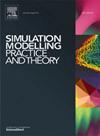集成仿真和数据驱动子模型的数字孪生耦合策略的主动学习置信度度量
IF 3.5
2区 计算机科学
Q2 COMPUTER SCIENCE, INTERDISCIPLINARY APPLICATIONS
引用次数: 0
摘要
在科学文献中,关于数字双胞胎的发展提出了许多挑战,这些数字双胞胎可以从数据流中预测生产过程的未来状态。本研究关注的是它们的几个子模型的协调,以平衡精度和计算需求。提出了一种利用基于流的主动学习采样策略对两个模型进行耦合的方法。两种模型执行相同的预测任务,但各有优缺点。第一种是仿真模型,它应该具有高保真度,但速度较慢。第二种是机器学习模型,它速度很快,但准确性较低,需要训练许多标记的示例,这可能需要大量的时间和精力来收集。目标是在机器学习模型的预测中利用置信度度量。这些措施是用来耦合两个模型,并利用各自的优势。特别是,目标是在有限的计算能力下减少数字孪生的平均预测误差。此外,还介绍了该方法在锯木厂中的应用和数值实验。本文章由计算机程序翻译,如有差异,请以英文原文为准。
Active learning confidence measures for coupling strategies in digital twins integrating simulation and data-driven submodels
Many challenges have been raised in the scientific literature regarding the development of digital twins that can predict future states of production processes from data streams. This study is concerned with the coordination of several of their submodels to balance precision with computational requirements. A method to use stream-based active learning sampling strategies to couple two such models is proposed. Both models perform the same prediction task but have different advantages and disadvantages. The first is a simulation model that is supposed to have a high fidelity level, but to be slow. The second is a machine learning model, which is fast but less accurate and requires many labeled examples to be trained on, which may require a lot of time and effort to gather. The objective is to leverage confidence measures in the predictions of the machine learning model. These measures are used to couple the two models and take advantage of their respective strengths. In particular, the aim is to reduce the digital twin’s average prediction error while operating under limited computational capacity. Moreover, an application within the sawmill industry and numerical experiments are presented.
求助全文
通过发布文献求助,成功后即可免费获取论文全文。
去求助
来源期刊

Simulation Modelling Practice and Theory
工程技术-计算机:跨学科应用
CiteScore
9.80
自引率
4.80%
发文量
142
审稿时长
21 days
期刊介绍:
The journal Simulation Modelling Practice and Theory provides a forum for original, high-quality papers dealing with any aspect of systems simulation and modelling.
The journal aims at being a reference and a powerful tool to all those professionally active and/or interested in the methods and applications of simulation. Submitted papers will be peer reviewed and must significantly contribute to modelling and simulation in general or use modelling and simulation in application areas.
Paper submission is solicited on:
• theoretical aspects of modelling and simulation including formal modelling, model-checking, random number generators, sensitivity analysis, variance reduction techniques, experimental design, meta-modelling, methods and algorithms for validation and verification, selection and comparison procedures etc.;
• methodology and application of modelling and simulation in any area, including computer systems, networks, real-time and embedded systems, mobile and intelligent agents, manufacturing and transportation systems, management, engineering, biomedical engineering, economics, ecology and environment, education, transaction handling, etc.;
• simulation languages and environments including those, specific to distributed computing, grid computing, high performance computers or computer networks, etc.;
• distributed and real-time simulation, simulation interoperability;
• tools for high performance computing simulation, including dedicated architectures and parallel computing.
 求助内容:
求助内容: 应助结果提醒方式:
应助结果提醒方式:


